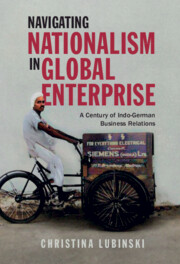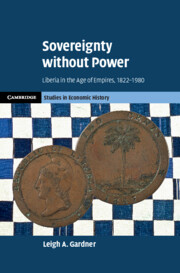Refine search
Actions for selected content:
26945 results in Economic history
Contents
-
- Book:
- Navigating Nationalism in Global Enterprise
- Published online:
- 27 October 2022
- Print publication:
- 03 November 2022, pp vii-vii
-
- Chapter
- Export citation
Appendix 3: - Imports from Germany into India
- from Appendices
-
- Book:
- Navigating Nationalism in Global Enterprise
- Published online:
- 27 October 2022
- Print publication:
- 03 November 2022, pp 256-256
-
- Chapter
- Export citation
2 - Before the Dragons Came
- from Part I - Foundations
-
- Book:
- Sovereignty without Power
- Published online:
- 27 October 2022
- Print publication:
- 03 November 2022, pp 33-57
-
- Chapter
- Export citation
Dedication
-
- Book:
- Sovereignty without Power
- Published online:
- 27 October 2022
- Print publication:
- 03 November 2022, pp v-vi
-
- Chapter
- Export citation
Appendices
-
- Book:
- Navigating Nationalism in Global Enterprise
- Published online:
- 27 October 2022
- Print publication:
- 03 November 2022, pp 252-256
-
- Chapter
- Export citation
Index
-
- Book:
- Sovereignty without Power
- Published online:
- 27 October 2022
- Print publication:
- 03 November 2022, pp 335-340
-
- Chapter
- Export citation
Tables
-
- Book:
- Navigating Nationalism in Global Enterprise
- Published online:
- 27 October 2022
- Print publication:
- 03 November 2022, pp ix-ix
-
- Chapter
- Export citation
8 - An African Marshall Plan
- from Part III - Sovereignty for Sale?
-
- Book:
- Sovereignty without Power
- Published online:
- 27 October 2022
- Print publication:
- 03 November 2022, pp 191-216
-
- Chapter
- Export citation
Conclusion: Rehistoricizing Nations
-
- Book:
- Navigating Nationalism in Global Enterprise
- Published online:
- 27 October 2022
- Print publication:
- 03 November 2022, pp 246-251
-
- Chapter
- Export citation
Part II - The Art of Survival
-
- Book:
- Sovereignty without Power
- Published online:
- 27 October 2022
- Print publication:
- 03 November 2022, pp 91-188
-
- Chapter
- Export citation
3 - Mapping Enemies in World War I
- from Part I - Nationalism and Competitive Dynamics
-
- Book:
- Navigating Nationalism in Global Enterprise
- Published online:
- 27 October 2022
- Print publication:
- 03 November 2022, pp 75-94
-
- Chapter
- Export citation
1 - The Invention of Nationality
- from Part I - Nationalism and Competitive Dynamics
-
- Book:
- Navigating Nationalism in Global Enterprise
- Published online:
- 27 October 2022
- Print publication:
- 03 November 2022, pp 25-47
-
- Chapter
- Export citation
SUSTENANCE AND STRIFE. STANDARDS OF LIVING AND FAMILY VULNERABILITY DURING SPAIN'S INDUSTRIALISATION. THE BILBAO ESTUARY, 1914-1935
-
- Journal:
- Revista de Historia Economica - Journal of Iberian and Latin American Economic History / Volume 41 / Issue 2 / September 2023
- Published online by Cambridge University Press:
- 02 November 2022, pp. 273-304
- Print publication:
- September 2023
-
- Article
-
- You have access
- Open access
- HTML
- Export citation

Navigating Nationalism in Global Enterprise
- A Century of Indo-German Business Relations
-
- Published online:
- 27 October 2022
- Print publication:
- 03 November 2022

Sovereignty without Power
- Liberia in the Age of Empires, 1822–1980
-
- Published online:
- 27 October 2022
- Print publication:
- 03 November 2022
Stock exchange regulation and the official price lists of the stock exchanges of Brussels and Antwerp, 1801–1935
-
- Journal:
- Financial History Review / Volume 29 / Issue 3 / December 2022
- Published online by Cambridge University Press:
- 24 October 2022, pp. 342-357
-
- Article
-
- You have access
- Open access
- HTML
- Export citation
FHR volume 29 issue 2 Cover and Back matter
-
- Journal:
- Financial History Review / Volume 29 / Issue 2 / August 2022
- Published online by Cambridge University Press:
- 11 October 2022, pp. b1-b2
-
- Article
-
- You have access
- Export citation
Banking crises, banking mortality and the structuring of the banking market in Switzerland, 1850–2000
-
- Journal:
- Financial History Review / Volume 29 / Issue 2 / August 2022
- Published online by Cambridge University Press:
- 11 October 2022, pp. 247-270
-
- Article
-
- You have access
- Open access
- HTML
- Export citation
FHR volume 29 issue 2 Cover and Front matter
-
- Journal:
- Financial History Review / Volume 29 / Issue 2 / August 2022
- Published online by Cambridge University Press:
- 11 October 2022, pp. f1-f2
-
- Article
-
- You have access
- Export citation
RESOURCE ENDOWMENTS, AGENCY PROBLEMS, AND MONETARY OUTCOMES IN TWO COLONIAL AMERICAN MINTS, 1600-1700
-
- Journal:
- Revista de Historia Economica - Journal of Iberian and Latin American Economic History / Volume 41 / Issue 2 / September 2023
- Published online by Cambridge University Press:
- 30 September 2022, pp. 343-373
- Print publication:
- September 2023
-
- Article
- Export citation
